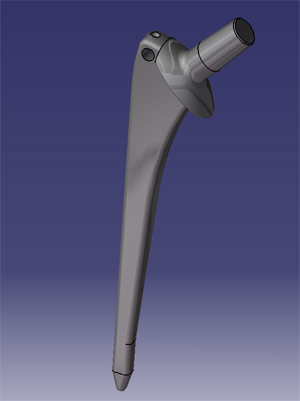
ProjectTR – 19030A
Development of Plasma-Spray Coatings Based on Hydroxyapatite for Surgical Implants Obtaining
Duration: 01/04/2008 – 31/12/2010
Funded by: Ministry of Science and Technological Development of Republic of Serbia
Organization: Institute for Technology of Nuclear and Other Mineral Raw Materials – ITNMS, Belgrade
Project leader: Zvonko Gulišija, PhD, principal research fellow

Objectives:
The subject of this project is development of hydroxyapatite coatings which, deposited onto the metallic implant, could enable production of a new generation surgical implants – cementless hip prosthesis. Cementless implant durability is twice longer than the cement one, and its adhesion to the bones is not just mechanical, but also biological. Actual surgery implants are usually made of titanium alloys or stainless steels with deposited hydroxyapatite (HAp) coating. Hydroxyapatite is chemically identical with the mineral constituent of bones and teeth, what provides its biocompatibility. This material limitations are, however, weak tensile strength and low fatigue resistance for long term loadings, if used alone. When HAp is deposited onto the surgical implant, besides biocompatibility, the bioactivity is also achieved, what means intergrowth with bones. This enables long-lasting and mechanical stable non-cemented prosthesis. There are several contemporary techniques that have been used for deposition of these coatings onto the metal implant. Efforts here are focused on: plasma-spray processing technique and electrophoretic deposition of HAp.
The advantage of plasma-spray coating process is the possibility of depositing materials with high melting point, such as refractories and ceramics. These coatings are more compact, harder and cleaner. There is a wide range of possibilities to influence the structure, bioactive and mechanical features through the process parameters change.
Electrophoretic deposition process advantages are: high utilization degree of raw material, good deposition possibilities on complex shapes, uniform layer thickness, and easy automation of the process.
Deposited coatings characterization encompasses the microstructure analysis of figures obtained by both, the optical and scanning electron microscopy, determination Ca/P ratio is done using EDX, phase composition determination by XRD and porosity determination from figures, using appropriate software. Adsorption/desorption kinetics can be determined from measuring of dissolution in simulated body fluid for short- and long-term examinations, at human body temperature and at elevated temperatures, as well.
Investigators:
1. Zvonko Gulišija, Ph.D., principal research associate, ITNMS
2. Zoran Janjušević, Ph.D., senior research associate, ITNMS
3. Marija Mihailović, M.Sc., research assistant, ITNMS
4. Aleksandra Patarić, M.Sc., research assistant, ITNMS
5. Milentije Stefanović, Ph.D., Professor at the Faculty of Mechanical Engineering in Kragujevac
6. Vesna Mandić, Ph.D., Associate Professor at the Faculty of Mechanical Engineering in Kragujevac
7. Srbislav Aleksandrović, Ph.D., Associate Professor at the Faculty of Mechanical Engineering in Kragujevac
8. Vesna Nikolić, M.Sc., research assistant, IHTM